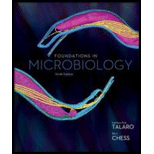
Concept explainers
What is the logic behind testing for E. coli to detect fecal contamination of water?
To determine:
The logic behind testing for E. coli to detect fecal contamination of water.
Introduction:
E. coli is a common inhabitant of the human intestine; it is also able to survive in the outside environment.
Explanation of Solution
Coliforms such as E. coli are used to detect fecal contamination in water samples due to their widespread presence in the human intestine. They are able to survive in the outside environment, and will therefore provide a reasonable inoculum for culture tests. They are also easier to culture than true pathogens. For this reason, they are used as the initial indicator for fecal contamination; their presence indicates the possible presence of true enteric pathogens such as Salmonella.
E. coli is used to detect fecal contamination in water due to the fact that it is a prominent inhabitant of the human intestine, it is able to survive in the environment and it is easier to culture than true enteric pathogens.
Want to see more full solutions like this?
Chapter 20 Solutions
Foundations in Microbiology
- can the phenol red test also be used to determine if a certain bacterium can metabolze various carbohydrates?arrow_forwardWhy is it critical to be able to determine the overall number of bacteria present in a food sample?arrow_forwardWhy can EMB agar be used to detect the presence of E. coli in particular? Explain the principle of detection of the organism using EMB agararrow_forward
- What would be the expected out come of a Nitrate reduction test If the bacteria is a pathogenic intestinal bacteria?arrow_forwardWhy is Escherichia coli used as an indicator organism inmicrobial analyses of water?arrow_forwardWhat is the difference between a mixed culture and a contaminated culture if they both contain more than one type of organism ?arrow_forward
- Why is CFU more applicable to a culture of streptococcus than to a culture of E.coliarrow_forwardWhat is the purpose of the confirmed test in an experiment designed to test for coliform bacteria?arrow_forwardWhat is the most difficult type of microbial cell or structure to kill? What methods can be used to sterilize a sample contaminated with these?arrow_forward
- If coliforms were present on a plated sample, would you know with certainty that the coliforms are disease-causing? Why or why not?arrow_forwardIs there any pH buffering system or device for acidic microbiological experiments?arrow_forwardWhat is the rationale for selecting E. coli as the indicator of water potability?arrow_forward
